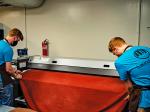TULSA, Okla. — When Matt Poe and I first talked about me writing an article concerning plant flooding, I meant to use my experience with nuisance flood recovery, how to save electric motors and such from being destroyed in a flood.
Unfortunately since that conversation, our plant was involved in a major flood that resulted in over 5 feet of water throughout our facility.
While we were able to save our machinery, we were not able to restore electrical power to our facility for two weeks. This forced us to close our facility. Even our best healthcare clients could not go two weeks without linen.
I did learn more valuable information that I would like to pass on to readers of American Laundry News, just in case you find yourself in the same predicament.
We all give written backup plans to our customers. In case of an emergency, this is how we will produce linen for you. Two days into our backup plan, we knew we were in trouble. Our backup plan could only produce about 10% of our daily needs.
So, being realistic about your backup plan is my first suggestion. As healthcare laundries get larger, it is getting harder for us to back each other up. It is one thing to ask someone to help you out with 5,000 sheets for a day but something completely different to ask them to help you out with 15,000 sheets and 15,000 blankets, not just for a day, but every day for a week.
When you talk about your backup plans, use real numbers to ensure your backup can actually produce the amount of linen they will need to produce for you.
There are several steps that can be taken after the water recedes to rapidly get your plant running again. I will discuss a few of them below.
Renting or purchasing a floor scrubber is a real game changer in cleaning up the plant. The ability to vacuum up all that mud/water instead of pushing it around with a mop or pressure washer really speeds up the process.
There are several industrial equipment rental companies that can help you with this.
Long ago in my maintenance career, we had made it a daily game plan to turn the power off to our machinery every evening.
This is not in preparation for a flash flood in the middle of the night but due more to power surges that seem to happen at night. There is nothing worse than leaving a machine in great running condition at the end of a shift only to find it will not start the next morning.
This does help with the No. 1 rule of flood recovery. Electrical components that get wet when no power is on are not damaged unless they are re-energized before the water is removed. You can pretty much save everything if you keep that one philosophy in mind.
Electric motors—there are a few methods you can use to save your motors. The most dependable method is to dismantle them and have them baked overnight at your local motor repair shop. They do not need to be rewound, just baked.
I would suggest this method if your local shop can work them in. If you cannot get this accomplished, having a fan blow on the windings for a day does the trick just as well.
The fastest way to save an electrical motor is to put very low voltage on the motor that will allow it to dry out without shorting out. I do not know about any of your facilities, but we are certainly not equipped to perform this type of drying.
No matter what method you use, you will need to change the bearings. Water has amazing abilities to clean out sealed bearings. You may get the motor to run with old bearings, but it will not be for long.
Electronic boards—you would think that boards would just automatically be gone at the first sign of water, but they are tough. You do need to remove them from their slots or any electrical connections, clean the connections with contact cleaner and thoroughly blow them out. That lint that we all fight every day will get wet and attach itself in a way that will short the boards out.
Cleaning all components while they are dry will save them and make them dependable going forward.
Gas regulator—any natural gas regulator that was under water will need to be replaced. If your natural gas provider knows you have been flooded, they will ensure you do this before they turn your gas back on.
You will want to change them if you are forced to or not; they will no longer work correctly going forward so they will cost you more money in gas usage than the replacement cost is.
Your ironer chest must be cleaned as soon as possible. If you wait more than a week to start cleaning them, then you can only remove the rolls and clean the chests manually. Water will pit up the chests making them hard to run linen. Removing the rolls and buffing the chests is the only solution.
If you plan on storing the ironer versus starting it right back up, you will want to apply a small amount of oil to the chests to stop them from rusting again. I prefer linseed oil since it is easy to remove when you are ready to run your ironer again.
Water will make it into your air system. If you simply just turn the air back on you will flood all your valves and air solenoids with water. Isolate your machines as much as possible to clear the water out.
The longer you wait to get them going the higher probability it will be that they will rust up. Replace as many of these as possible; you can dismantle them and clean them up and save them.
Post flooding will make you want to pick your battles on what to rebuild versus replace; pneumatic parts usually fall into the replace category.
Finally, losing a facility is devastating to everyone involved, especially employees. There was a large section of employees that had no intention of ever leaving the job they were performing. No matter the pay grade of the employee, their life has been turned upside down.
If you are forced to close the facility you should work with the unemployment office to try and find jobs for these displaced employees. Our employees are our responsibility until they find a new position with a new company.
Have a question or comment? E-mail our editor Matt Poe at [email protected].

















































